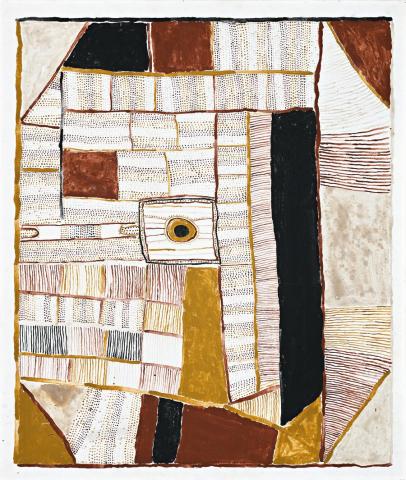UNTITLED, 1998
KUTUWULUMI PURAWARRUMPATU (KITTY KANTILLA)
natural earth pigments and synthetic binder on canvas
92.0 x 79.0 cm
inscribed verso: artist's name and Jilamara Arts and Crafts cat. 980266
Jilamara Arts and Crafts, Melville Island (stamped verso)
Aboriginal and Pacific Art, Sydney
Private collection, Sydney
Sotheby's, Melbourne, 24 June 2002, lot 30
Private collection, New South Wales
Kitty Kantilla Kutuwalumi Purawarrumpatu, Aboriginal and Pacific Art, Sydney, 1 - 24 October 1998
Kitty Kantilla, National Gallery of Victoria, Melbourne, 27 April - 19 August 2007; Art Gallery of New South Wales, Sydney, 7 December 2007 - 21 January 2008, cat. 60 (label attached verso)
Ryan, J., Kitty Kantilla, National Gallery of Victoria, Melbourne, 2007, p. 53 (illus.)
Kitty Kantilla achieved much acclaim during her painting career. A pioneer of women artists from the Tiwi Islands, Kantilla first began producing intricate bark paintings and decorated carvings with a group of Tiwi women in the 1970s. Living a traditional life during her childhood at Yimpinari with her mother and father, Kantilla grew up speaking old Tiwi, eating bush foods and sleeping in paper-bark shelters during the wet season. Having undergone initiation as part of her education and witnessing her father painting jilamara (designs) for the Pukumani (funeral) ceremony, Kantilla was imbued with Tiwi rituals and the associated designs.
She began making collaborative sculpture with her third husband Larry Kantilla in 1978 and ten years later Kantilla exhibited sixteen sculptures in Carved Wooden Sculptures by Tiwi Women from Paru at Aboriginal Artists Gallery, Sydney. By the early 1990s she had ceased carving and was instead painting her traditional designs on paper and canvas, Kitty Kantilla's Untitled 1998 is significant for being one of the earlier works to represent a fundamental shift away from her characteristic black ground by the introduction of a white ground. Kantilla's black ground works were a more literal translation of the Tiwi body paint decoration for which she had become so well known. It was this dramatic transition to white canvas that catapulted her work into the realm of deep abstraction, as though a light had been turned on all the cultural ceremonial elements Kantilla had been taught to paint by her father. As Judith Ryan astutely observed,'The white surface broke the direct link between surface of object or body and two-dimensional painting and introduced stronger tonal contrasts, giving life to dramatic divisions of space, larger fields of colour and the adventurous use of squares and lines within rectangles on a white wall.'1
1. Ryan, J., 'Dot Dot'- the Art of Kitty Kantilla', in Meridian: Focus on Contemporary Australian Art, Museum of Contemporary Art, Sydney, 2002, p. 99
